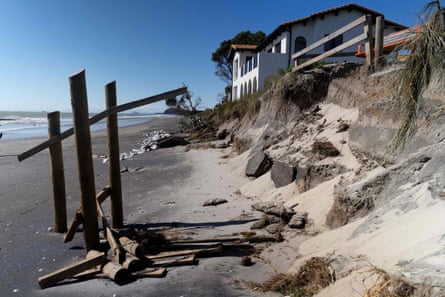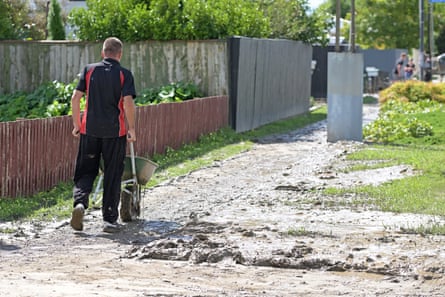[ad_1]
In the New Zealand city of Napier, black army helicopters hum overhead. Leonard Fleming has damp clothes, no food and faces a third night sleeping in his car with his dogs Beadle and Mika. Fleming knows he has likely lost everything he left behind when he fled his home in nearby Eskdale, Hawke’s Bay, ahead of Cyclone Gabrielle on Monday.
“I’ve never had my house burned to the ground but I imagine it’s the same thing,” he tells the Guardian over a crackling phone line; service to the area is recently restored but coverage is intermittent. “All you can do is run away and I started thinking this morning about all the stuff that I’ve lost.”

The ex-tropical cyclone which lashed New Zealand’s North Island on Monday and Tuesday – with high winds and heavy rain wreaking havoc in more than half a dozen regions – was the worst storm to hit New Zealand this century, said the prime minister, Chris Hipkins, whose government announced a rare national state of emergency on Tuesday.
Four deaths have been confirmed by the police, including a child whose body was found in Eskdale on Wednesday afternoon.
The trail of damage included fatal landslips, closed highways that cut off towns, flooding so severe and rapid that hundreds of people awaited rescue on their roofs, and widespread power, water and telecommunications outages. Some of the worst-affected areas were rural towns that were isolated even before the storm hit, with potholed roads and patchy cellphone reception.
Even as painstaking restoration of services continued on Wednesday, communication woes made it difficult to assess the scale of the devastation.
Fleming hoped those ferried back and forth in the army helicopters above him on Wednesday included his neighbours in Eskdale – a rural settlement 25km north of Napier. Some had stayed behind when he evacuated two days ago and now cannot be reached by phone.
The Esk River across the street from Fleming’s house breached its banks on Tuesday morning and he was told that water at surrounding properties reached roof level. Fleming cannot return home – or travel to the nearby city of Hastings to stay with his son – because bridges and state highways in the area are impassable due to flooding, slips and downed trees.
Army trucks and air force helicopters were sent to rescue hundreds of people in Hawke’s Bay on Tuesday as residents of cut-off settlements took to their roofs. Warnings were issued by civil defence officials on Sunday that residents of several areas should prepare to evacuate, but for many, the perilous speed of the rising water came as a shock.
Jenna Marsh from central Hawke’s Bay said the water rose metres in minutes at her parents’ house in Pakowhai – a town between Hastings and Napier. Her mother had told her everything was fine as she fed her horses on Tuesday morning.

“Less than an hour later she texts me saying, ‘We’re on the roof,’” Marsh says. Her mother estimated the water level had risen by about three metres in 10 minutes.
Marsh’s parents spent eight hours on the roof before they were rescued by helicopter, carrying nothing but their two dogs.
“They had to pick between rescuing grab bags or their dogs and they picked their dogs,” Marsh says.
The family’s pet goat was left bobbing in a boat and they hope to find their horses, one of which was last seen swimming past the house.
The government says there are major animal welfare concerns for livestock and horses in rural areas lashed by the storm.
On Tuesday morning, a group of orchard workers – many of them apparently visiting seasonal workers from Tonga – made news headlines as they broadcast live on Facebook, some using mattresses as flotation devices and others sheltering on the roof of their accommodation. They were rescued on Tuesday afternoon by the army.

The communications blackout in Hawke’s Bay provoked panic for relatives living abroad. One family in Bogotá, Colombia, whose 15-year-old son arrived in New Zealand a fortnight ago for a six-month exchange program, were not able to reach him for two days.
Juan Sebastian Lopez says his younger brother, Tomas, is staying with a host family in Taradale, Napier, where evacuations were widespread. The family had felt reassured by New Zealand’s relative safety when they farewelled “our prince” on his first solo adventure abroad – and watched the news of rising flood waters in horror.
“We never imagined that this was even possible,” Lopez says.
Frantic with worry – and still unable to contact Tomas or his host family on Wednesday morning – the family filled in a police missing person form and waited. Lopez was overjoyed when Tomas and his host family were able to briefly confirm their safety on Wednesday afternoon, after traveling to a location with working wifi. More than 1,400 people have been registered with the police as uncontactable.

Further north in Coromandel, widespread power cuts left residents in slip-prone beach settlements unsure about what was happening outside their towns and worried about food supplies running out if the roads to the peninsula cannot be reopened quickly.
Claire Moyes, her husband and their visiting guests, spent two “terrifying” nights with “thunder, lightning and wind right on top of us”. Worried the stream beside their property would flood their home, the group dug trenches to funnel rising water away from their driveway.
“It came all the way up to the garage twice during high tide,” Moyes said, but their house was spared. Most of the houses nearby are holiday homes, and the couple spent Tuesday checking their neighbours’ properties.
By Wednesday, they had not showered in three days, and while power was briefly restored, it was not expected to last.

Bigger problems loom: the coastal settlement is reliant on tourism, and Moyes said a mudslide at one of the peninsula’s best-known spots, Cathedral Cove – which is now closed – and erosion at popular Hahei beach would have lasting effects on the local economy.
“But at the moment, it’s just like, how can we get supplies? How can we feed ourselves for the next few days? How can we shower? How can we get out of here?” Moyes said.
In Napier, Leonard Fleming has dog food, coffee and a burner to brew it on – but no food and no access to his bank account to buy more due to power cuts. He does not want to seek refuge at an evacuation centre.
“When you’re in this situation, all you really want to do is just go home, relax, put your feet up and get a nice sleep in a cosy, warm bed but it’s all gone,” he said. “That’s really starting to sink in.”
[ad_2]
#survivors #Cyclone #Gabrielle #describe #sense #loss #despair
( With inputs from : www.theguardian.com )

